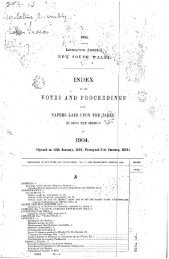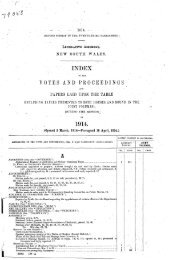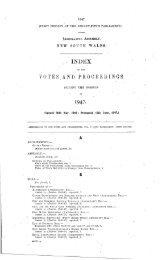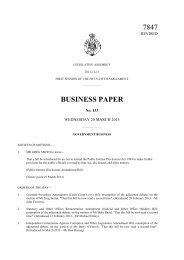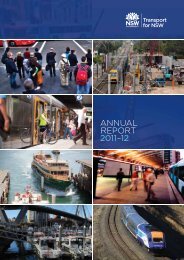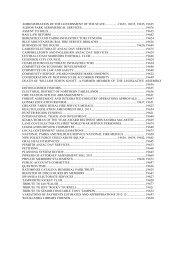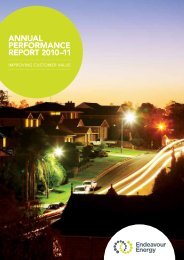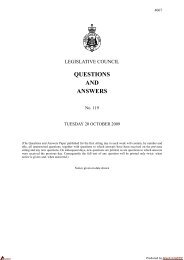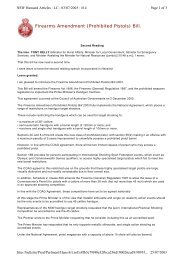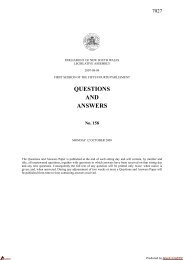AGNSW_AnnRep_00 full.pdf - Parliament of New South Wales ...
AGNSW_AnnRep_00 full.pdf - Parliament of New South Wales ...
AGNSW_AnnRep_00 full.pdf - Parliament of New South Wales ...
Create successful ePaper yourself
Turn your PDF publications into a flip-book with our unique Google optimized e-Paper software.
ART GALLERY OF NEW SOUTH WALES TRUST<br />
NOTES TO AND FORMING PART OF THE FINANCIAL<br />
STATEMENTS FOR THE YEAR ENDED 30 June 2<strong>00</strong>0<br />
1 SUMMARY OF SIGNIFICANT ACCOUNTING POLICIES<br />
(a) Reporting entity<br />
The Art Gallery <strong>of</strong> <strong>New</strong> <strong>South</strong> <strong>Wales</strong> comprises all the<br />
operating activities and entities under the control <strong>of</strong> the<br />
Board <strong>of</strong> Trustees <strong>of</strong> the Art Gallery <strong>of</strong> <strong>New</strong> <strong>South</strong> <strong>Wales</strong><br />
(the Gallery) including the Gallery’s commercial activities <strong>of</strong><br />
merchandising, venue hire and catering. All transactions<br />
and balances between the funds and entities comprising the<br />
Gallery have been eliminated in the process <strong>of</strong> preparing<br />
the financial statements. The Art Gallery <strong>of</strong> <strong>New</strong> <strong>South</strong><br />
<strong>Wales</strong> Foundation is not included, as the Gallery has no<br />
direct control over the activities <strong>of</strong> the Foundation. The<br />
principal object <strong>of</strong> the Foundation is to raise funds to be<br />
invested and to apply the income derived from such<br />
investments to the acquisition <strong>of</strong> works <strong>of</strong> art for the<br />
Gallery.<br />
(b) Basis <strong>of</strong> accounting<br />
These financial statements which are a general purpose<br />
financial report have been prepared on an accruals basis<br />
and in accordance with applicable Australian Accounting<br />
Standards and other authoritative pronouncements <strong>of</strong> the<br />
Australian Accounting Standards Board (AASB), Urgent<br />
Issues Group (UIG) the requirements <strong>of</strong> the Public Finance<br />
and Audit Act and Regulations, and the Financial Reporting<br />
Directions published in the Financial Reporting Code for<br />
Budget Dependent General Government Sector Agencies or<br />
issued by the Treasurer under section 9(2)(n) <strong>of</strong> the Act.<br />
Where there are inconsistencies between the above<br />
requirements, the legislative provisions have prevailed. In<br />
the absence <strong>of</strong> a specific Accounting Standard, other<br />
authoritative pronouncement <strong>of</strong> the AASB or UIG<br />
Consensus View, the hierarchy <strong>of</strong> other pronouncements as<br />
outlined in AAS 6 “Accounting Policies” is considered.<br />
Except for certain investments and land, building, property<br />
plant and equipment and infrastructure systems, which are<br />
recorded at valuation, the financial statements are prepared<br />
in accordance with the historical cost convention. All<br />
amounts are rounded to the nearest one thousand dollars<br />
and are expressed in Australian currency. The accounting<br />
policies adopted are consistent with those <strong>of</strong> the previous<br />
year.<br />
(c) Change <strong>of</strong> Accounting Policy<br />
There were no changes to Accounting Policy in the financial<br />
year to 30 June 2<strong>00</strong>0.<br />
(d) Revenue Recognition<br />
Revenue is recognised when the Trust has control <strong>of</strong> the<br />
good or right to receive, it is probable that the economic<br />
benefits will flow to the Trust and the amount <strong>of</strong> revenue<br />
can be measured reliably. Additional comments regarding<br />
the accounting policies for the recognition <strong>of</strong> revenue are<br />
discussed below.<br />
38<br />
(i) <strong>Parliament</strong>ary Appropriations and Contributions from<br />
Other Bodies<br />
From this financial year there is a change in accounting<br />
policy for the recognition <strong>of</strong> parliamentary appropriations.<br />
<strong>Parliament</strong>ary appropriations are generally recognised as<br />
revenues when the agency obtains control over the assets<br />
comprising the appropriations/contributions. Control over<br />
appropriations and contributions is normally obtained<br />
upon receipt <strong>of</strong> the cash.<br />
An exception to the above is when appropriations are<br />
unspent at year-end. In this case, the authority to spend<br />
the money lapses and generally the unspent amount<br />
must be repaid to the Consolidated Fund in the following<br />
financial year. As a result, unspent appropriations are now<br />
accounted for as liabilities rather than revenue.<br />
(ii) Sale <strong>of</strong> Goods and Services<br />
Revenue from the sale <strong>of</strong> goods and services comprises<br />
revenue for the provision <strong>of</strong> products or services ie. user<br />
charges. User charges are recognised as revenue when<br />
the agency obtains control <strong>of</strong> the assets that result from<br />
them.<br />
(e) Employee entitlements<br />
(i) Wages and salaries, annual leave, sick leave and oncosts<br />
Liabilities for wages and salaries, annual leave and<br />
vesting sick leave are recognised and measured as the<br />
amount unpaid at the reporting date at current pay rates<br />
in respect <strong>of</strong> employees’ services up to that date. Under<br />
the awards operating in the Gallery, sick leave is nonvesting.<br />
The Trustees are <strong>of</strong> the opinion that total sick<br />
leave paid in any one year will not exceed leave<br />
entitlements for the year and therefore no liability exists<br />
in respect <strong>of</strong> leave accumulated. The outstanding<br />
amounts <strong>of</strong> payroll tax, workers’ compensation insurance<br />
premiums and fringe benefits tax which are consequential<br />
to employment are recognised as liabilities and expenses<br />
where the employee entitlements to which they relate<br />
have been recognised.<br />
(ii) Long service leave and superannuation<br />
The Gallery’s liability for long service leave and<br />
superannuation are assumed by the Crown Entity. Long<br />
service leave is measured on a nominal basis. The Gallery<br />
accounts for the liability as having been extinguished<br />
resulting in the amount assumed being shown as part <strong>of</strong><br />
the non-monetary revenue items described as<br />
“Acceptance by the Crown Entity <strong>of</strong> Employee<br />
Entitlements and Other Liabilities” Refer Note 12. The<br />
nominal method is based on the remuneration rates at<br />
year-end for all employees with five or more years <strong>of</strong><br />
service. It is considered that this measurement technique<br />
produces results not materially different from the<br />
estimate determined by using the present value basis <strong>of</strong><br />
measurement.



